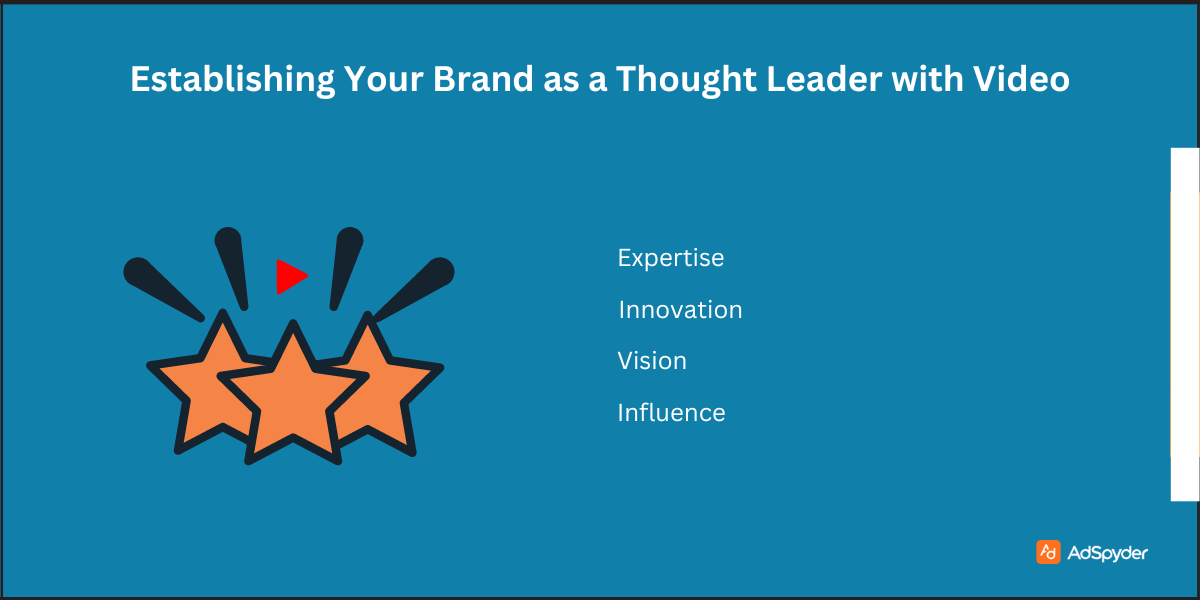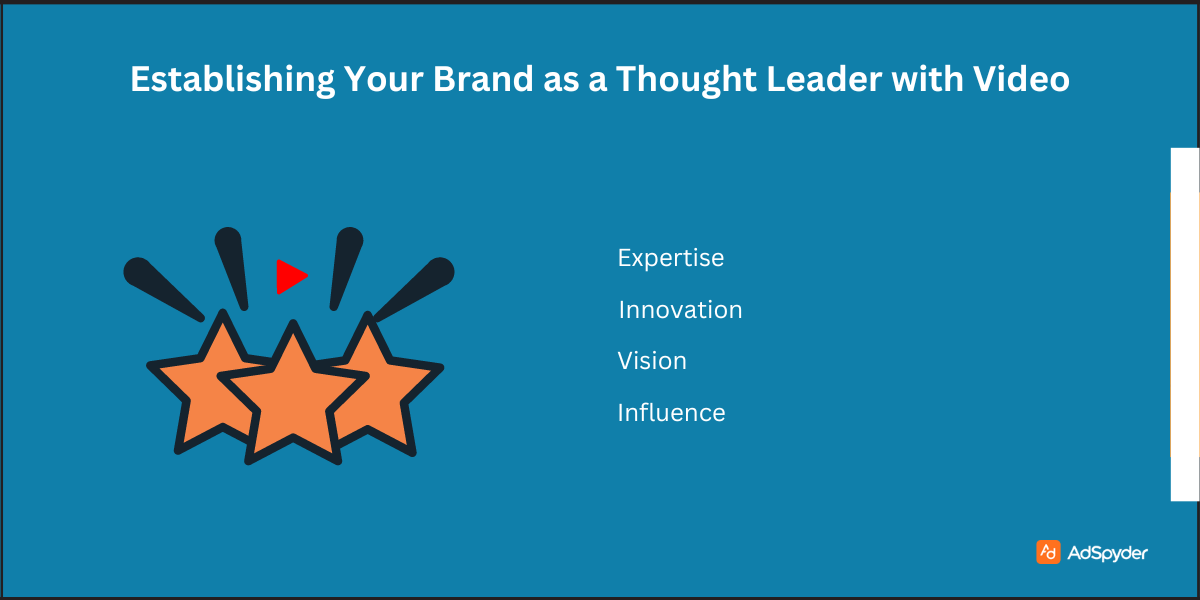The business landscape of recent times is much more evolved than it ever was. However, with more businesses and advancement, comes the pressure to win in a competition against the other businesses to be a leader. Of course, nobody wants to walk a blind path where another competitor leads the way. Especially not, if you’re trying to make a name in the industry. This is why you need to pick up pace and establish your brand as a thought now, more than ever. One of the ways of doing this is creating video content for thought leadership.
Ready to Elevate your Marketing Strategy?
This content builds credibility, fosters trust, and ultimately drives business success. How do you do that efficiently? Well, there are many ways to achieve this, one of which is video content. This is why we’re here today. In this comprehensive guide, we’re going to scroll through different ways in which you can establish video content for thought leadership and gain knowledge on how you can create insightful and authoritative video content.
Summary
Before we step into all the details about this, let’s start by taking a quick summary of all the contents that we’ll cover in this blog :
- The role of thought leadership in building a brand’s credibility and trust.
- The benefits of using video content for thought leadership.
- Strategies for creating and distributing thought leadership videos.
- Tips for creating insightful and authoritative video content.
- A detailed FAQ section addressing some of your most commonly asked questions about thought leadership and video content.
By the end of this blog, you are going to have a comprehensive understanding of how you can leverage video content to establish thought leadership and enhance your brand’s influence.
Establishing Your Brand as a Thought Leader with Video

As complex as it sounds, establishing your brand as a thought leader is not that much of a task if you plan it efficiently.
Understanding Thought Leadership
Now learning in detail about something that you only have a vague idea about can really hurt your head. So, let’s first understand what thought leadership actually is.
Definition and Significance
Thought leadership is the practice of positioning your brand as an authority and a reliable source of valuable information in your industry. It involves sharing your expertise, insights, and innovative ideas with your audience. Thought leadership is essential for building credibility and trust, attracting and retaining customers, and differentiating your brand from competitors.
Key Characteristics
Here are some attributes of thought leaders :
- Expertise: Deep knowledge and understanding of your industry.
- Innovation: Ability to offer new perspectives and solutions.
- Vision: Clear and forward-thinking approach.
- Influence: Capacity to inspire and lead others.
Examples of well-known thought leaders in various industries include Elon Musk in technology and innovation, Simon Sinek in leadership and organizational culture, and Marie Forleo in entrepreneurship and personal development.
Benefits of Video content for Thought Leadership
Here is how video benefits your thought leadership venture :
Engagement and Reach
Video content is highly engaging and has the potential to reach a wide audience. It combines visual and auditory elements to capture attention and convey messages clearly and compellingly performs exceptionally well in terms of views, shares, and engagement compared to other content formats. For example, according to HubSpot, 54% of consumers want to see more video content from brands they support.
Humanizing Your Brand
Video content allows you to put a face to your brand, making it more relatable and authentic. By showcasing the people behind your brand and sharing their stories, you can build personal connections with your audience. Authentic and relatable video content fosters trust and loyalty, humanizing your brand and making it more approachable.
Strategies for Establishing Thought Leadership with Video
Let’s take a look at some exciting strategies that can be made use of for establishing thought leadership with the help of videos.
Educational Content
Creating educational videos such as tutorials, how-to videos, and explainer videos is a powerful way to showcase your expertise. These videos provide valuable information and insights, helping your audience solve problems or learn new skills. Tips for making educational content engaging and informative include using clear visuals, breaking down complex concepts, and incorporating practical examples.
Industry Insights
Sharing industry trends, analysis, and predictions through video content establishes your brand as a source of valuable and up-to-date information. For example, a video discussing the latest developments in artificial intelligence and their impact on various industries can position your brand as a forward-thinking leader. Ensure your insights are well-researched and presented in a clear and compelling manner.
Interviews and Q&A Sessions
Conducting interviews with industry experts and thought leaders can add credibility to your video content. Hosting live Q&A sessions allows you to engage with your audience in real-time, answering their questions and addressing their concerns. This live stream marketing and interactive format combo fosters a sense of community and positions your brand as approachable and knowledgeable.
Case Studies and Success Stories
Highlighting case studies and success stories demonstrates your brand’s impact and expertise. These videos showcase real-life examples of how your products or services have helped customers achieve their goals. Tips for creating compelling case study videos include focusing on the customer’s experiences, highlighting specific challenges and solutions, and using testimonials to add authenticity.
Watch out: Video Marketing for Travel: Boost Your Tourism Brand in 2025
Tips for Creating Insightful and Authoritative Video Content for Thought Leadership

Having given you a broad idea about thought leadership and strategies to achieve it, here are a few tips that might be helpful :
Understanding Your Audience
To resonate with your audience, the first and obvious step is to know your audience.
Audience Research
Conduct thorough research to understand your audience’s needs, interests, and pain points. Use surveys, interviews, and analytics to gather insights into what your audience values most. Tailor your video content to address these needs and provide solutions.
Targeting Specific Segments
Create content that addresses the unique needs of different audience segments. Personalizing your video content increases its relevance and engagement. For example, a software company might create separate videos for small businesses, large enterprises, and individual users, each highlighting features and benefits relevant to those segments.
Content Planning and Scripting
In order to create the best content, you’ll need to put in enough effort. The first and foremost step would be to plan and script your content.
Developing a Content Strategy
Having a clear content strategy is crucial for thought leadership. Develop a content calendar outlining your video topics, goals, and publication schedule. Ensure your content aligns with your brand’s overall marketing strategy and objectives.
Scriptwriting Tips
Crafting a compelling and informative script is essential for engaging video content. Start with a strong hook to capture attention, and maintain clarity and conciseness throughout. Use a conversational tone, and structure your script logically, with a clear beginning, middle, and end. Practice your script to ensure a smooth and confident delivery.
Production Quality and Presentation
Once it’s all been planned out, the next step would be to produce your much awaited video.
Investing in Quality Production
High production quality is important for establishing credibility and professionalism. Ensure good video and audio quality, proper lighting, and clean editing. Investing in quality equipment and production services can make a significant difference in the final product.
On-Camera Presence
Presenting confidently and authentically on camera is key to connecting with your audience. Maintain good posture, make eye contact with the camera, and use natural gestures. Practice your delivery, and seek feedback to refine your on-camera presence. Authenticity and confidence can significantly enhance your video’s impact.
Distribution and Promotion
After the last few steps, you can further move on to ways in which you can promote and distribute your content so it reaches your target audience.
Optimizing for SEO
Optimizing your videos for search engines is crucial for improving visibility and reach. Use relevant keywords in titles, descriptions, and tags. Include transcriptions and captions to make your videos accessible and searchable. Promote your videos on your website, blog, and social media channels to drive traffic and engagement.
Leveraging Social Media
Social media platforms are powerful channels for distributing and promoting your video content. Tailor your videos to fit the format and audience of each platform. For example, shorter, attention-grabbing videos work well on Instagram and Twitter, while longer, more in-depth videos are suitable for YouTube and LinkedIn. Engage with your audience by responding to comments, sharing user-generated content, and participating in conversations.
Engaging with Your Audience
Building a community around your video content involves actively engaging with your audience. Respond to comments, questions, and feedback on your videos. Encourage viewers to share their thoughts and experiences, and foster conversations around your content. Building a loyal and engaged audience enhances your brand’s credibility and influence.
Measuring Impact and Refining Strategy
Just like the fruit from a tree you’ve planted, the measurement of the impact of your strategies is like the much-awaited result :
Tracking Performance Metrics
Monitoring key performance metrics helps you understand the impact of your thought leadership videos. Track metrics such as views, engagement, shares, and feedback. Use analytics tools to gather insights into viewer behavior and preferences.
Continuous Improvement
Use the insights gained from performance data to refine and improve your video content strategy. Experiment with different formats, topics, and promotion techniques. Stay updated with industry trends and audience preferences to ensure your content remains relevant and impactful.
FAQs
Thought leadership involves establishing your brand as an authority and trusted source of information in your industry. It builds credibility, trust, and influence, helping to attract and retain customers.
Video content can engage and reach a wider audience, humanize your brand, and showcase your expertise. It allows you to share valuable insights, educate your audience, and build personal connections through authentic and relatable content.
Effective types of video content for thought leadership include educational videos, industry insights, interviews with experts, Q&A sessions, and case studies. These formats allow you to share your knowledge, provide valuable information, and demonstrate your expertise.
To ensure your video content is engaging and informative, focus on understanding your audience’s needs, interests, and pain points. Create a content strategy, craft compelling scripts, invest in quality production, and present confidently on camera.
Optimize for SEO, leverage social media, engage with your audience, and track performance metrics. Promote your videos across various platforms and respond to comments and feedback.
To improve your on-camera presence, practice presenting confidently and authentically. Maintain good posture, make eye contact with the camera, and use natural gestures. Practice your delivery and seek feedback to refine your performance.
Track key performance metrics such as views, engagement, shares, and feedback. Use analytics tools to gather insights and refine your video content strategy based on performance data. Continuously monitor and analyze your videos’ performance.
Conclusion
Recap
Establishing thought leadership through video content involves creating engaging, insightful, and authoritative videos that showcase your expertise. By understanding your audience, planning your content, investing in quality production, and promoting your videos effectively, you can build credibility and trust with your audience.
Final Thoughts
Thought leadership is a powerful tool for building your brand’s reputation and influence. By leveraging video content, you can reach a wider audience, provide valuable insights, and establish your brand as a trusted authority in your industry.
Call to Action:
We encourage you to start creating thought leadership videos using the tips and strategies discussed in this blog. Share your experiences and insights in the comments below, and let’s build a community of brands that inspire and lead through valuable and authoritative content.




